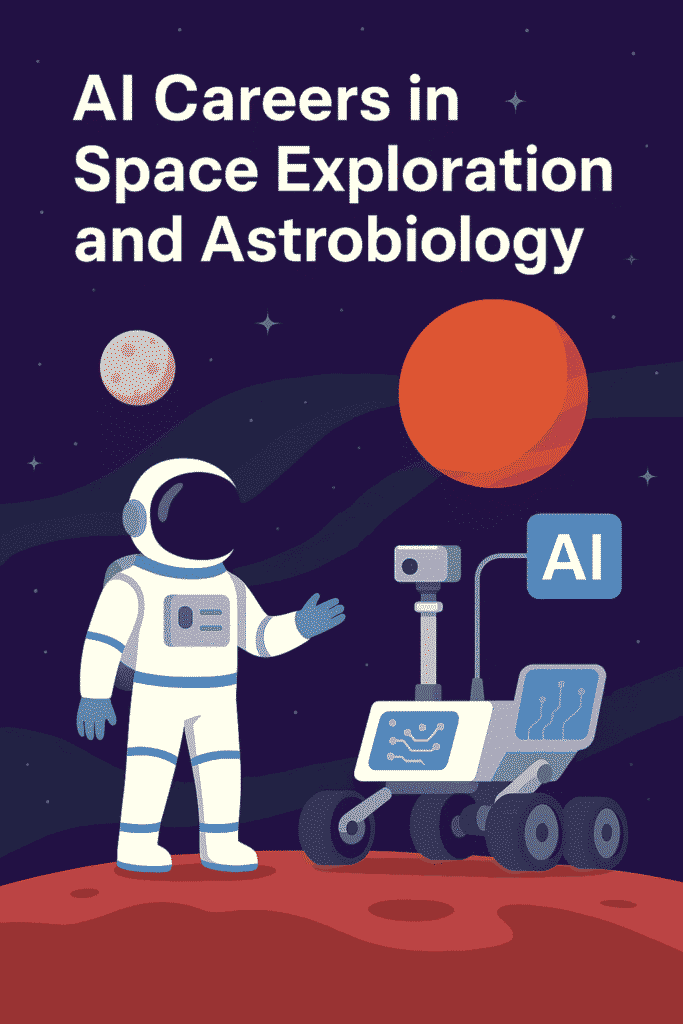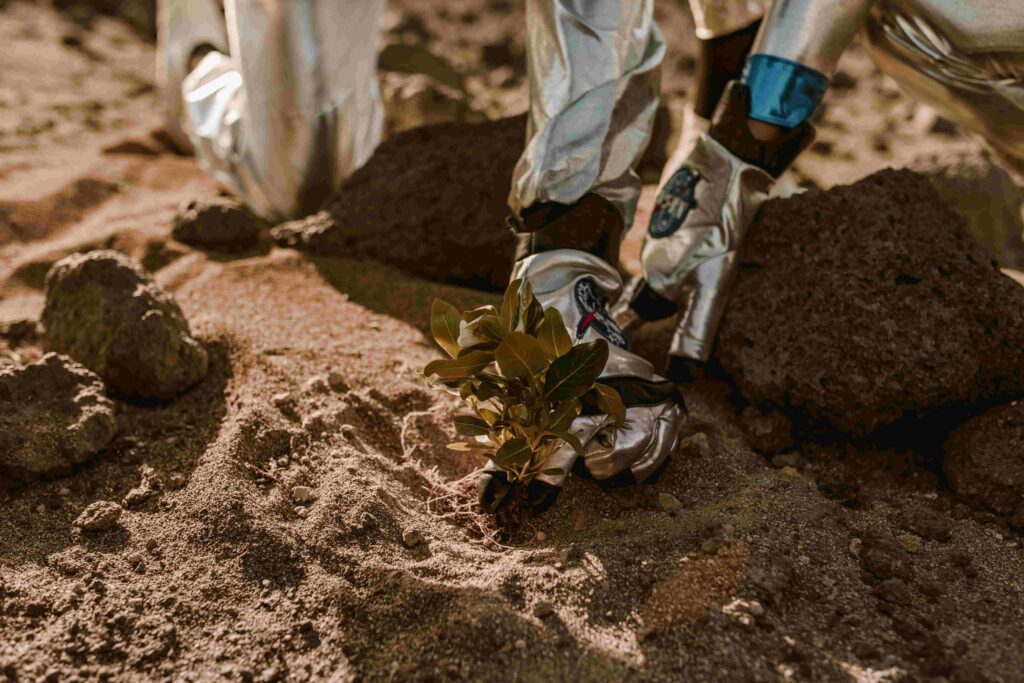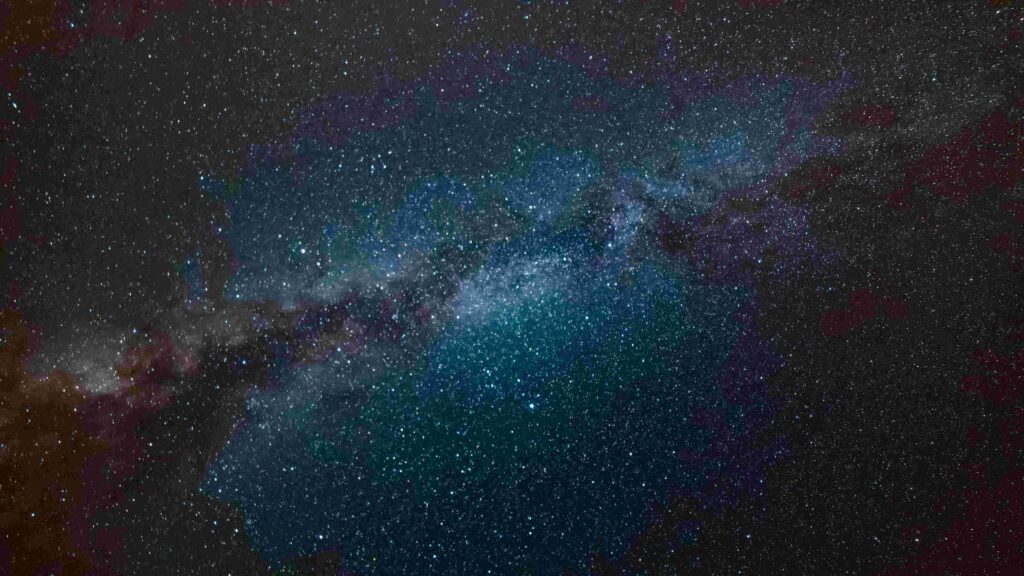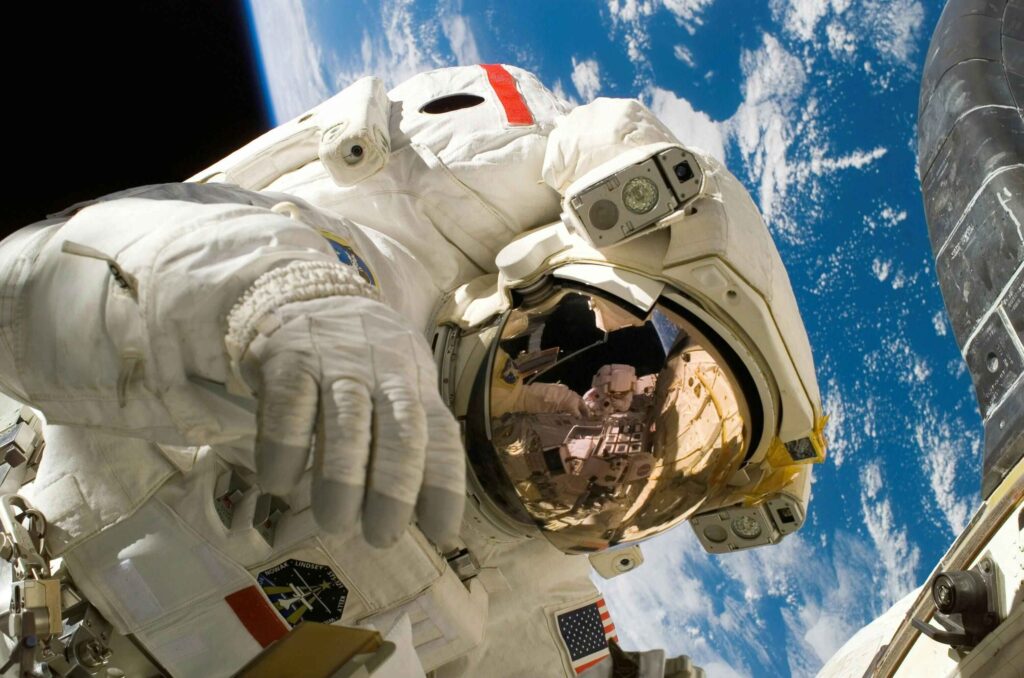
Table of Contents
Part 1: The Dawn of AI in Space Exploration and Astrobiology
Space has always been the final frontier of human curiosity. From ancient stargazers mapping the night sky to scientists launching interplanetary probes, the quest to understand the universe has never stopped. But in recent years, this pursuit has entered a new phase — one fueled by Artificial Intelligence (AI). AI is not just accelerating how we study the cosmos; it is transforming who can participate and how fast discoveries can be made.
The Growing Intersection of AI and Space Science
For decades, space exploration relied heavily on human expertise — teams of astronomers, engineers, and analysts manually processing vast amounts of data collected from telescopes, satellites, and probes. But as the volume of data skyrocketed, manual analysis became impossible. NASA’s telescopes alone generate petabytes of data every year, and upcoming missions like the James Webb Space Telescope and ESA’s Euclid mission are expected to multiply that tenfold.
This explosion of data demands automated systems capable of sorting, interpreting, and learning from complex datasets — exactly where AI shines. Using machine learning (ML), deep neural networks (DNNs), and computer vision, AI systems now detect anomalies, classify celestial objects, and even predict cosmic phenomena with astonishing accuracy.
How AI Transformed Space Exploration
The first serious experiments with AI in space exploration began in the early 2000s. NASA’s Autonomous Sciencecraft Experiment used onboard AI to make real-time decisions about imaging Earth’s surface. Later, Mars rovers like Curiosity and Perseverance began using AI-driven navigation systems to traverse the Martian landscape safely. These systems analyze terrain data, predict hazards, and select optimal routes without constant human input from mission control.
Today, AI’s role extends far beyond navigation:
- Satellite health monitoring: Detecting faults and predicting system failures using predictive analytics.
- Astronomical data classification: AI identifies galaxies, stars, and exoplanets faster than teams of scientists.
- Signal detection: Machine learning models help sift through radio signals for potential extraterrestrial communications.
- Mission design and optimization: AI assists in plotting efficient trajectories and resource allocation for space missions.
Astrobiology Meets AI: The Search for Life Beyond Earth
Astrobiology — the study of life in the universe — stands to gain immensely from AI. This interdisciplinary field combines biology, chemistry, geology, and astronomy to answer the ultimate question: Are we alone? The challenge lies in identifying biosignatures — chemical or physical signs of life — hidden in vast datasets from distant planets and moons.
AI now helps analyze spectroscopic data from Mars, Europa, and Enceladus to identify potential organic molecules. For instance, deep learning algorithms trained on terrestrial microbial signatures can predict whether unknown chemical patterns could originate from biological processes.
NASA’s ExoMiner AI, developed to analyze exoplanet data from the Kepler and TESS missions, can distinguish between real planets and false signals with over 90% accuracy — outperforming many traditional models.
Why AI Is Indispensable to Modern Space Science
Space missions generate more data than humans can ever process manually. AI bridges that gap by providing:
- Speed: Algorithms process and classify data in seconds.
- Precision: AI minimizes human bias in pattern recognition.
- Scalability: It can handle terabytes of data continuously.
- Autonomy: Spacecraft can make decisions in real time, essential for missions far from Earth.
Imagine a future mission to Europa, one of Jupiter’s icy moons. Communication delays can take 30–50 minutes for a single round trip. Human operators cannot manually guide every move. An AI-enabled probe could autonomously decide where to drill for samples, what to analyze, and when to transmit findings — functioning as an independent explorer.
Key Domains Where AI Plays a Role in Space Science
| Domain | AI Application | Outcome |
|---|---|---|
| Planetary Exploration | Terrain mapping, rover navigation | Safer, faster exploration |
| Astronomy | Galaxy classification, signal detection | Accurate celestial mapping |
| Astrobiology | Biosignature detection, molecular analysis | Faster identification of life indicators |
| Satellite Operations | Predictive maintenance | Reduced mission failures |
| Mission Planning | Trajectory optimization | Lower costs and higher efficiency |
The Emerging Job Ecosystem Around AI in Space
The integration of AI into space science is creating new career avenues that didn’t exist a decade ago. Professionals now work at the crossroads of AI engineering, data science, robotics, and planetary science. Agencies like NASA, ESA, ISRO, and private firms like SpaceX, Blue Origin, and Planet Labs are hiring experts who can combine algorithmic intelligence with space mission objectives.
Some of the emerging job titles include:
- AI Systems Engineer (Space Missions)
- Planetary Data Scientist
- Astrobiology Research Analyst (AI Focus)
- Machine Learning Engineer for Satellite Analytics
- Space Robotics Software Developer
Each of these roles demands not just programming expertise but also a deep understanding of astrophysics and mission environments.
AI’s Role in Democratizing Space Research
Previously, space exploration was the domain of large governments. But AI and automation have lowered the entry barriers. Startups can now analyze satellite imagery, simulate missions, and even predict asteroid trajectories using cloud-based AI systems. This democratization of space data means more private players, universities, and even citizen scientists can contribute to discoveries.
Platforms like Google Earth Engine, ESA’s Copernicus Open Access Hub, and NASA’s Planetary Data System (PDS) allow AI researchers worldwide to access real mission data for free — fostering innovation and education.
How This Trend Shapes the Job Market
AI’s influence in space isn’t limited to research labs. The commercial sector is booming too. Companies specializing in satellite imaging, space debris tracking, remote sensing, and climate monitoring are integrating AI for efficiency. The result? A surge in job demand for professionals skilled in:
- Computer vision and deep learning
- Astrophysical data modeling
- Remote sensing analytics
- Reinforcement learning for robotics
- Quantum computing in simulation-based missions
How Artificial Intelligence Is Transforming Space Exploration – Robotics, Navigation, and Data Intelligence
The next generation of space exploration is defined not only by rockets and satellites but also by intelligent systems that think, learn, and decide. AI has become the invisible pilot behind modern missions — from orbiting satellites to Mars rovers and even interstellar probes. This section dives deep into how AI drives every aspect of space exploration and how these advancements are generating new career opportunities across engineering, research, and data science.
1. Autonomous Space Robotics: The New Astronauts
Human presence in deep space is limited by physiological, environmental, and logistical challenges. The solution lies in autonomous robots that can function intelligently for months or years without human intervention.
AI enables these robots to perceive, adapt, and respond to unknown terrains.
a. The Mars Rover Revolution
NASA’s Curiosity and Perseverance rovers mark the pinnacle of AI-driven autonomy. Their Self-Driving AI Navigation System, called AEGIS (Autonomous Exploration for Gathering Increased Science), helps the rover identify promising rocks and soil samples.
It decides what to analyze and sends compressed, prioritized data back to Earth — saving bandwidth and time.
- AI Skills Used: Computer vision, path-planning algorithms, terrain segmentation.
- Career Roles: Space robotics engineer, embedded AI developer, planetary mission software specialist.
- Industries Hiring: NASA JPL, ISRO robotics division, and private exploration startups like Astrobotic and iSpace.
b. The Rise of Swarm Robotics
Future missions to the Moon and asteroids will deploy swarms of mini-robots — intelligent micro-rovers and drones that coordinate through AI. These swarms can map terrains, locate resources, and build structures autonomously.
AI algorithms enable:
- Distributed decision-making (without a central command).
- Real-time collaboration through reinforcement learning.
- Damage resilience — if one robot fails, others adapt and complete the mission.
Job Prospects:
Swarm robotics specialists, multi-agent system engineers, and AI simulation experts are becoming vital roles in upcoming lunar missions.
2. AI in Spacecraft Navigation and Mission Control
Traditional space navigation relied on manual trajectory correction and pre-programmed commands. But as we venture farther — to Mars, Titan, and beyond — communication delays make real-time control impossible.
Enter AI-based autonomous navigation systems.
a. Deep-Space Navigation Algorithms
Spacecraft like NASA’s DART mission (which deliberately collided with an asteroid in 2022) used onboard AI to guide itself toward a target millions of kilometers away.
The AI analyzed visual data and adjusted its course without human interference.
Key technologies:
- Optical navigation using deep learning models.
- Neural networks trained on star-field images for self-positioning.
- AI-assisted thruster optimization for fuel efficiency.
Career Paths:
Aerospace data scientist, onboard AI engineer, autonomous flight systems designer.
b. Predictive Maintenance and Spacecraft Health
AI is also the doctor of spacecraft — continuously monitoring temperature, radiation exposure, and mechanical wear. Predictive analytics detect faults before they become mission-ending failures.
NASA’s MISSE-FF (Materials International Space Station Experiment – Flight Facility) used AI to track how materials degrade in orbit, ensuring safer spacecraft design.
Companies now employ predictive AI engineers who build diagnostic algorithms for satellites, rovers, and propulsion systems.

3. AI-Powered Data Analysis in Astronomy
Space missions generate colossal amounts of raw data — images, signals, spectra, and telemetry. Analyzing this flood manually is impossible. AI helps scientists extract meaningful insights from trillions of data points.
a. Identifying Celestial Objects with Machine Learning
Projects like Galaxy Zoo and Sloan Digital Sky Survey (SDSS) have leveraged AI to classify galaxies, stars, and quasars based on morphology and light spectra.
Neural networks can now detect exoplanets by analyzing subtle dips in starlight curves — something even experienced astronomers might overlook.
- Skills Needed: Deep learning, TensorFlow, PyTorch, Python, astronomical data modeling.
- Careers: Astroinformatics scientist, exoplanet detection specialist, AI data analyst for space missions.
b. Signal Detection and SETI
The Search for Extraterrestrial Intelligence (SETI) project now depends on AI to detect narrow-band radio signals that could indicate extraterrestrial communication.
AI models filter billions of radio frequencies, eliminating noise from Earth-based interference.
This application has created roles like AI signal processing engineer and astrodata researcher, who design algorithms to find potential “technosignatures.”
4. AI and Satellite Operations
Satellites form the backbone of modern civilization — enabling GPS, communication, weather forecasting, and defense. Managing thousands of satellites in orbit requires intelligent automation.
a. AI for Orbital Traffic and Debris Management
With over 8,000 active satellites and hundreds of thousands of debris fragments orbiting Earth, AI plays a crucial role in preventing collisions.
Machine-learning systems analyze orbital trajectories to predict possible conjunctions and automatically adjust paths.
Startups like LeoLabs and Kayhan Space specialize in this domain, offering AI-driven “space traffic control” services.
This is creating jobs such as:
- Orbital AI systems analyst
- Space situational awareness (SSA) engineer
- Collision-avoidance data scientist
b. AI in Earth Observation Satellites
AI helps analyze satellite imagery for climate monitoring, agriculture, disaster management, and urban planning.
For example, ESA’s Sentinel missions use machine learning to process petabytes of Earth data daily — identifying deforestation, pollution, and ice-cap changes in near-real time.
Job Fields Emerging:
- Remote-sensing AI developer
- Geospatial data scientist
- Environmental AI researcher
5. Designing Smarter Missions with AI
AI isn’t limited to post-launch operations — it’s also revolutionizing mission planning and design.
a. Trajectory Optimization
AI algorithms simulate millions of possible flight paths to find the most fuel-efficient trajectory.
The European Space Agency uses evolutionary AI (inspired by natural selection) to evolve the best solutions for orbital transfers and docking maneuvers.
b. Resource Allocation and Scheduling
Space agencies juggle dozens of missions simultaneously. AI scheduling tools optimize the use of antennas, ground stations, and scientists’ time.
This automation improves efficiency while reducing operational costs — an essential factor as private players enter the race.
c. Virtual Testing and Simulation
Before a spacecraft is ever built, AI-driven digital twins simulate mission conditions.
Engineers can test materials, propulsion systems, and communication delays virtually — minimizing risks during launch.
6. Career Opportunities in AI-Driven Space Exploration
As AI becomes embedded in every stage of space missions, the demand for hybrid professionals — those who understand both aerospace engineering and machine learning — is exploding.
| Career Role | Core Responsibilities | Average Global Salary |
|---|---|---|
| AI Aerospace Engineer | Develop intelligent flight and navigation systems | $110,000 – $150,000 |
| Space Robotics Developer | Program autonomous rovers/drones for exploration | $95,000 – $140,000 |
| Astroinformatics Data Scientist | Analyze astronomical datasets using AI models | $100,000 – $155,000 |
| Satellite AI Analyst | Optimize satellite operations using predictive models | $90,000 – $130,000 |
| AI Research Scientist (Astrophysics) | Develop new algorithms for signal detection and analysis | $120,000 – $180,000 |
Note: Salaries vary by organization, experience, and country.
7. Skills and Tools in Demand
To build a career in this interdisciplinary field, professionals must blend technical AI expertise with domain-specific space knowledge.
Core AI Skills:
- Machine learning & deep learning
- Reinforcement learning for robotics
- Computer vision for terrain and object detection
- Predictive analytics & anomaly detection
- Natural language processing (for mission communication)
Space-Specific Skills:
- Astrophysics and orbital mechanics
- Spacecraft systems engineering
- Remote sensing and satellite telemetry
- Programming (Python, C++, MATLAB)
- Data visualization (Matplotlib, Plotly, Tableau)
Certifications from organizations like NASA’s Frontier Development Lab (FDL), Udemy Space AI Programs, or ESA AI Bootcamps can give professionals an edge.
8. AI’s Role in Future Missions
Upcoming missions like NASA’s Artemis Program, Lunar Gateway, and Mars Sample Return will rely heavily on AI for:
- Autonomous landing systems
- In-situ resource utilization (extracting materials from lunar soil)
- AI-assisted space construction using 3D printing robots
- AI-controlled deep-space communication
These innovations are paving the way for self-sustaining off-world colonies, and those who master AI will lead the charge.
9. Challenges in AI-Space Integration
Despite its promise, AI in space exploration faces hurdles:
- Limited computing power in space-grade hardware.
- Data latency and bandwidth constraints.
- Explainability: AI decisions must be transparent to mission controllers.
- Radiation effects can corrupt AI models or onboard processors.
This opens research positions for professionals working on radiation-hardened AI chips, lightweight neural networks, and trustworthy AI frameworks.
Artificial Intelligence in Astrobiology – Searching for Life Beyond Earth
For decades, the search for life beyond Earth — known as astrobiology — has fascinated scientists and dreamers alike. But with the vastness of the universe and limited human capability to process the massive data from telescopes and planetary probes, this quest was once like searching for a single drop in an ocean.
Now, with Artificial Intelligence (AI) leading the charge, the search for life in the cosmos has become smarter, faster, and far more efficient.
1. What Is Astrobiology, and Why Does AI Matter?
Astrobiology is the interdisciplinary science that explores the origin, evolution, and distribution of life in the universe. It combines biology, chemistry, astronomy, geology, and computer science. However, space missions generate terabytes of raw data daily, making manual analysis nearly impossible.
That’s where AI steps in. Machine learning algorithms can analyze:
- Planetary chemical compositions
- Atmospheric gases
- Terrain textures
- Thermal signatures
- Spectral patterns
…to identify possible signs of biosignatures — indicators of biological activity.
AI thus helps scientists prioritize which planets or moons deserve closer inspection, drastically improving the efficiency of space exploration.
2. AI for Detecting Biosignatures
A biosignature can be anything from specific atmospheric gas ratios to microscopic fossils or organic molecules. Detecting these signatures involves sifting through enormous datasets — something AI excels at.
a. Spectroscopic Analysis
Space telescopes such as the James Webb Space Telescope (JWST) capture light spectra from exoplanet atmospheres.
AI models can analyze these spectra to identify gases like oxygen, methane, or water vapor — key indicators of potential life.
For example:
- AI models like DeepBioSpec have been trained to recognize spectral fingerprints of biological molecules.
- Machine learning filters out cosmic noise and enhances faint signals that humans might miss.
Careers Emerging Here:
- Spectral data scientist
- AI planetary chemist
- Astrobiological data analyst
b. Image Recognition in Planetary Exploration
When rovers or orbiters capture images of other worlds (e.g., Mars, Europa, Titan), AI-driven computer vision algorithms analyze them for unusual textures or color patterns that could indicate biological or geological activity.
NASA’s Perseverance Rover uses AI for rock-sample prioritization, choosing where to drill or collect samples.
This has opened new positions like:
- Remote sensing AI engineer
- Planetary imagery analyst
- Machine vision developer for robotic missions
3. AI in Exoplanet Discovery
Discovering planets beyond our solar system, or exoplanets, is one of astronomy’s greatest achievements — and AI has become the backbone of this revolution.
NASA’s Kepler and TESS missions record light curves (brightness over time) of stars. When a planet crosses in front of its star, the light dims slightly. AI algorithms can detect these subtle patterns faster and more accurately than humans.
Examples of AI Breakthroughs:
- Google AI partnered with NASA to identify two previously missed exoplanets from Kepler’s dataset.
- Deep learning models now predict planetary habitability indices, ranking planets by potential for sustaining life.
In-demand Career Roles:
- Exoplanet AI researcher
- Astronomical data engineer
- Predictive modeling specialist for exoplanet systems

4. AI and Habitability Modeling
Determining whether a planet can sustain life involves analyzing hundreds of parameters — atmospheric density, temperature, chemical composition, radiation exposure, etc.
Traditional models took years to compute. AI can do it in hours.
Machine learning models simulate planetary ecosystems, predicting whether microbes, plants, or even intelligent organisms could survive.
By integrating Earth-based biology data with planetary simulation data, scientists can train AI to identify “Earth-like” conditions elsewhere.
Job Opportunities Emerging:
| Career Role | Description | Key Skills |
|---|---|---|
| AI Astrobiologist | Develop machine learning models for identifying life-supporting conditions | Bioinformatics, ML modeling, astrochemistry |
| Planetary Simulation Scientist | Create digital models of alien worlds and ecosystems | Physics simulation, neural modeling |
| Astrodata Systems Engineer | Manage and process planetary datasets for AI analysis | Data architecture, Python, cloud computing |
5. AI-Driven Tools and Missions in Astrobiology
Let’s look at some active missions and projects where AI has become the core driver of discovery.
a. NASA’s Frontier Development Lab (FDL)
FDL partners with Google Cloud and NVIDIA to apply AI in astrobiology, planetary defense, and space weather.
Their models have improved predictions of asteroid trajectories and enhanced data analysis for biosignature detection.
b. ExoMars Mission
The European Space Agency’s ExoMars Rover uses AI to decide where to drill and how to analyze soil samples for organic compounds.
AI helps ensure maximum scientific return while minimizing operational risk.
c. SETI and Deep Learning
AI is now central to the Search for Extraterrestrial Intelligence (SETI). Neural networks scan radio signals from deep space, filtering interference and isolating potential communication signals.
Recent AI models processed over 1.5 million radio spectra — identifying anomalies that may warrant further study.
d. Bioinformatics in Space
Space biology missions such as those on the International Space Station (ISS) use AI to analyze how microorganisms and human cells respond to zero gravity.
AI-powered sequencing tools detect mutations and adaptation patterns faster than traditional lab analysis.
Result: AI accelerates discoveries that could redefine our understanding of life and survival in extreme environments.
6. Interdisciplinary Nature of AI and Astrobiology Careers
Astrobiology and AI integration is inherently multidisciplinary. It requires a blend of computer science, biology, physics, and astronomy — a rare skill set that’s becoming highly valuable.
Core Skills Needed:
- Machine learning & data science
- Bioinformatics & systems biology
- Planetary science and remote sensing
- Astrophysics and quantum chemistry
- Programming (Python, R, MATLAB, TensorFlow)
Preferred Degrees:
- MSc/PhD in Astrobiology, Astronomy, AI, or Computational Biology
- Specialization in AI-driven data modeling
- Online certifications in Space Data Analysis or ML for Astronomy
Key Employers:
- NASA’s Ames Research Center
- European Space Agency (ESA)
- Blue Origin & SpaceX AI divisions
- Planet Labs
- Research universities (Caltech, MIT, ISRO’s AI Center)
7. AI for Detecting Non-Carbon-Based Life Forms
Traditional biology assumes life must be carbon-based. However, AI enables scientists to move beyond that bias.
By simulating alternative biochemistries (e.g., silicon-based or ammonia-based life), machine learning can predict non-terrestrial biological signatures.
This opens an entirely new frontier of astrobiology careers:
- AI Molecular Modeler: Builds simulation models for alternative life chemistries.
- Extraterrestrial Ecology Researcher: Studies how alien ecosystems might evolve.
- AI Biosignature Specialist: Trains neural networks on datasets representing hypothetical alien biology.
The Astrobiology Institute of NASA and private research labs are funding projects specifically to explore AI-based non-traditional life detection.
8. Machine Learning in Microbial Genomics for Space Missions
Understanding how microorganisms behave in space is crucial. Microbes could both help and hinder long-term missions:
- Beneficial microbes can recycle waste or produce oxygen.
- Harmful ones might mutate and become resistant.
AI helps identify genetic variations in microbes under microgravity conditions.
Using machine learning, scientists can predict how microbial DNA evolves, leading to insights into space medicine, contamination control, and life support systems.
Career Focus Areas:
- Genomic AI Analyst (Space Biology Division)
- Computational Microbiologist
- Life Support AI Engineer
These experts ensure astronauts can live safely in space — a key step toward colonization.
9. AI and the Future of Extraterrestrial Exploration
The next decades will see AI-driven probes capable of making autonomous decisions far beyond human communication limits.
For example:
- Europa Clipper (launching soon) will use AI to analyze data from Jupiter’s icy moon Europa, believed to have a subsurface ocean.
- Future Titan and Enceladus missions will rely on AI to detect potential microbial life.
- Interstellar probes, traveling beyond our solar system, will require self-learning AI systems that evolve and adapt over decades.
AI will enable self-healing software, real-time problem solving, and dynamic learning — crucial for missions millions of miles from Earth.
10. Ethical and Philosophical Questions in AI-Astrobiology
As AI helps us approach questions about life beyond Earth, ethical and philosophical concerns arise:
- Should we contact extraterrestrial life if discovered?
- Can AI itself evolve into a form of non-biological intelligence that qualifies as “life”?
- How do we ensure AI models interpreting signals don’t inject human bias?
These discussions are spawning a new professional field: AI Ethics in Space Research.
Career Roles:
- Space AI Ethicist
- AI Policy Advisor (Space Missions)
- AI Interpretability Specialist
Institutes like the SETI Institute and Oxford’s Future of Humanity Institute are already conducting workshops on AI ethics in cosmic exploration.
11. Salary Insights and Global Career Outlook
The intersection of AI and astrobiology is still niche — which means high demand and high pay.
| Role | Average Salary Range | Typical Employers |
|---|---|---|
| AI Astrobiologist | $120,000 – $160,000 | NASA, ESA, academic labs |
| AI Planetary Data Scientist | $110,000 – $150,000 | Private space firms, universities |
| Exoplanet AI Researcher | $100,000 – $145,000 | NASA, SETI, Google AI partnerships |
| AI Bioinformatics Specialist | $95,000 – $135,000 | Space biology labs, biotech firms |
| AI Ethics Consultant (Space) | $85,000 – $130,000 | Think tanks, policy institutions |
The field is projected to grow by 45% in the next decade, with rising investment in AI-driven astrobiological missions.
Ethical Challenges and Future Possibilities in AI-Driven Space Careers
4.1 Ethical Dimensions of AI in Space Research
Artificial intelligence has become indispensable in space exploration, but with its power come deep ethical challenges. As AI systems make decisions about spacecraft navigation, mission prioritization, and even the classification of extraterrestrial signals, it raises a fundamental question: who is responsible when things go wrong?
Imagine a scenario where an AI system misclassifies a potential biosignature from Mars as noise, leading scientists to overlook one of humanity’s greatest discoveries. The stakes are incredibly high. The ethical debate often revolves around the autonomy vs. accountability problem — how much decision-making authority should AI have in an environment where communication delays make human oversight difficult?
To address this, agencies like NASA and ESA are developing AI governance frameworks that define clear lines of responsibility. The idea is not to replace human judgment but to ensure that AI serves as a trustworthy partner. Future space professionals working in AI-driven roles must therefore have a strong grounding not only in technical skills but also in AI ethics, bias management, and decision transparency.
4.2 Planetary Protection and AI Decision-Making
One of the most critical ethical aspects of space research is planetary protection — ensuring that we do not contaminate other worlds or bring harmful materials back to Earth. AI plays a huge role here, especially in automated sterilization systems and microbial contamination detection algorithms.
However, AI systems can sometimes make “efficient” decisions that overlook long-term consequences. For example, an AI algorithm optimizing for mission cost might recommend skipping certain sterilization procedures to save energy. Without strong ethical oversight, such recommendations could pose biological and diplomatic risks. This is why space agencies emphasize AI transparency and human-in-the-loop validation for critical operations related to planetary protection.
Future jobs in this domain include:
- AI Planetary Ethics Officer: Oversees the ethical implications of automated exploration systems.
- Biosecurity Data Analyst: Uses AI to track and manage potential contamination events.
- Space Compliance Engineer: Ensures adherence to global space treaties like the Outer Space Treaty and COSPAR guidelines.
4.3 AI and the Search for Extraterrestrial Intelligence (SETI)
SETI researchers now rely heavily on AI to process the immense volume of radio and optical signals received daily. AI models filter out interference from human-made sources and isolate anomalies that could indicate intelligent life. Yet, this automation introduces another ethical challenge: AI interpretation bias.
If an AI model is trained on human communication patterns, it may inadvertently overlook non-human patterns of intelligence. As a result, many researchers now advocate for “non-anthropocentric AI design”, meaning that AI systems should be trained with a broader understanding of potential signal structures beyond human logic.
AI-driven SETI research careers are gaining prominence, with roles such as:
- Astrodata Specialist: Develops algorithms to analyze and classify signals from space telescopes.
- Interstellar Communication Analyst: Studies AI models to simulate possible extraterrestrial communication forms.
- Deep Space Signal Engineer: Designs neural networks to detect faint, long-duration radio emissions.
4.4 Space Law, AI, and Data Ownership
Another emerging area of concern is AI and space law, particularly around data ownership. As AI systems autonomously generate and interpret space data, the question arises — who owns that data? If an AI on a private spacecraft discovers a new exoplanet, is the discovery credited to the company, the AI developer, or humanity as a whole?
Lawyers, policymakers, and technologists are now collaborating to update space governance frameworks. Careers in AI-driven space law are becoming increasingly lucrative. Professionals in this domain combine knowledge of international law, data rights, and algorithmic accountability.
Some emerging roles include:
- Space Policy Analyst (AI Focus): Advises governments and corporations on AI data use in space missions.
- Ethical AI Compliance Consultant: Ensures AI use in space complies with UN and national regulations.
- Interplanetary Intellectual Property Advisor: Manages ownership disputes over AI-generated data and discoveries.
4.5 The Future of AI in Human Spaceflight
AI is not only transforming robotic missions but also reshaping human space exploration. From health monitoring systems on the ISS to AI copilots in next-generation spacecraft, automation is becoming central to astronaut safety and performance.
For instance, NASA’s Robonaut and ESA’s CIMON are AI-driven assistants that help astronauts with tasks ranging from equipment repair to mental wellness support. In future Mars missions, AI systems will play a crucial role in psychological health, nutrition planning, and mission simulation.
Careers in this intersection include:
- AI Crew Health Specialist: Designs intelligent systems that monitor and predict astronaut health trends.
- AI Space Habitat Engineer: Develops AI models to maintain life-support systems in extraterrestrial colonies.
- Human-AI Interaction Designer (Space Systems): Ensures astronauts can intuitively interact with onboard AI tools.
4.6 AI in Terraforming and Planetary Engineering
AI may also contribute to one of humanity’s most ambitious goals — terraforming planets like Mars. By modeling atmospheric chemistry, climate evolution, and ecological balance, AI can simulate potential scenarios for making planets habitable.
Machine learning can analyze terabytes of geological and environmental data to identify regions with the highest potential for sustainable colonization. While still theoretical, this field has already given rise to new research jobs such as:
- Planetary Climate Modeler (AI-Driven): Uses AI to simulate climate shifts under terraforming conditions.
- Extraterrestrial Ecology Engineer: Integrates AI predictions into ecosystem design for off-world habitats.
- AI Sustainability Analyst for Space Colonies: Evaluates long-term resource cycles using predictive analytics.
4.7 The Role of AI in Space Manufacturing and Resource Extraction
Mining asteroids for rare minerals and manufacturing materials in zero gravity are two future industries where AI will be essential. AI can control robotic miners, monitor structural integrity, and optimize production in environments where human presence is limited or impossible.
SpaceX, Blue Origin, and emerging companies like Planetary Resources are investing heavily in AI-powered resource management systems. These systems use reinforcement learning to adapt to changing conditions during asteroid extraction or lunar construction.
Future career paths include:
- AI Robotics Engineer (Asteroid Mining): Designs AI systems for autonomous drilling and material handling.
- Orbital Production Manager: Oversees AI-controlled manufacturing systems in space stations.
- Space Resource Analyst: Uses AI to model economic and environmental impacts of off-world mining.
4.8 AI-Powered Interstellar Navigation and Communication
AI plays a crucial role in deep-space navigation by predicting orbital dynamics and correcting trajectories without human intervention. Projects like Breakthrough Starshot depend on AI to guide tiny spacecraft traveling at near-light speed to neighboring star systems.
AI also revolutionizes interplanetary communication, especially with the introduction of quantum communication and delay-tolerant networking (DTN). As distances increase, real-time communication becomes impossible — and AI helps prioritize and compress data intelligently to maintain mission efficiency.
Jobs emerging from this field include:
- AI Communication Systems Engineer: Develops algorithms for delay-tolerant deep-space networks.
- Autonomous Navigation Specialist: Designs self-learning systems to guide spacecraft through unknown gravitational fields.
- Quantum Data Scientist (Space Networks): Uses AI to enhance security and speed in quantum space communication.

Educational Pathways and Career Growth in AI-Driven Space Exploration and Astrobiology
5.1 Introduction to Learning Pathways
Pursuing a career in AI-driven space exploration and astrobiology demands a rare blend of technical expertise, scientific curiosity, and futuristic thinking. It’s one of the few domains where computer science meets astrophysics, robotics, biology, and ethics. Unlike traditional STEM fields, this interdisciplinary area values flexibility, problem-solving, and a constant hunger for discovery.
To thrive in this emerging industry, aspirants must focus on building a strong foundation in artificial intelligence, data science, physics, astronomy, biology, and robotics—while also understanding the ethical and legal frameworks that govern space research. Let’s explore the academic roadmap and skill development strategies for entering and advancing in this exciting field.
5.2 Undergraduate Foundations
At the undergraduate level, your choice of degree sets the tone for your future specialization. While no single program covers everything about AI and space, several combinations can help you build the right foundation:
Recommended Bachelor’s Degrees:
- B.Tech/B.E. in Computer Science (AI/ML Specialization): Focuses on algorithms, machine learning, and data systems that are later applied to space analytics and robotics.
- B.Sc in Astrophysics or Space Science: Offers deep insight into celestial phenomena, planetary systems, and physics principles.
- B.Sc in Biotechnology or Microbiology: Useful for careers in astrobiology and biosignature detection using AI.
- B.Tech in Robotics or Mechatronics Engineering: Perfect for those interested in AI-powered spacecraft design and autonomous rover systems.
During your undergraduate studies, focus on core subjects such as:
- Linear Algebra, Calculus, and Probability (for AI algorithms)
- Programming in Python, C++, and MATLAB
- Data Structures and Neural Networks
- Astrophysics and Planetary Science
- Space Robotics and Embedded Systems
You can further strengthen your profile by participating in projects like AI-powered satellite tracking, Mars rover simulations, or biosignal classification using machine learning.
5.3 Postgraduate Specializations
After your bachelor’s, pursuing a Master’s degree or integrated PhD can open the doors to advanced AI-space research roles. Many top universities and research organizations offer programs that merge artificial intelligence with aerospace and biological sciences.
Popular Master’s Programs:
- M.Sc in Artificial Intelligence and Space Science
- M.Tech in Aerospace Engineering with AI focus
- M.Sc in Astrobiology and Bioinformatics
- M.Sc in Data Science for Astronomy
- M.Tech in Robotics and Autonomous Systems
Some universities even offer specialized programs like Computational Astrophysics, Planetary Analytics, and AI for Space Missions, which prepare graduates for direct entry into organizations like NASA, ISRO, ESA, and private aerospace startups.
During postgraduate studies, students should focus on research-oriented projects, such as:
- Using deep learning for star cluster detection
- Developing AI systems to predict spacecraft component failures
- Applying generative AI to simulate alien biomes
- Using reinforcement learning for planetary landing optimization
5.4 Top Global Universities for AI and Space Careers
Many institutions across the world lead in combining AI with space and biological sciences. Below are some of the best universities offering programs aligned with AI-driven space exploration and astrobiology:
| Country | Top Universities | Notable Programs |
|---|---|---|
| USA | MIT, Stanford, Caltech, Carnegie Mellon University | AI & Robotics, Aerospace Systems, Computational Astrobiology |
| UK | University of Cambridge, University College London, Imperial College London | Machine Learning for Space Systems, Astrobiology |
| Germany | Technical University of Munich (TUM), Heidelberg University | Aerospace Engineering with AI integration |
| India | IIT Bombay, IISc Bangalore, IIIT Hyderabad | Space Robotics, Machine Learning, Astrophysics |
| Canada | University of Toronto, McGill University | Space Science and AI Data Analytics |
| Australia | Australian National University, University of Sydney | AI Applications in Space Exploration |
| Japan | University of Tokyo, Kyoto University | AI-driven Planetary Science |
Each of these universities collaborates closely with space agencies and private companies, providing access to projects like autonomous satellite control, AI-assisted mission planning, and bioinformatics for extraterrestrial research.
5.5 Certification and Online Learning Options
For professionals or students who want to enter the field without committing to a full-time degree, certifications can provide excellent stepping stones. Several reputed institutions and online platforms offer courses tailored for this domain.
Recommended Online Certifications:
- NASA’s Open Learning Program: Offers free modules on astrobiology, planetary science, and robotics.
- MIT OpenCourseWare (AI and Machine Learning): Covers neural networks, reinforcement learning, and computer vision.
- Coursera & edX: Courses like AI in Astronomy, Machine Learning for Space Exploration, and Space Mission Design.
- Udacity Nanodegree: AI for Robotics and Data Science for Space Applications.
- Google Cloud AI & TensorFlow Developer Certifications: Focus on deploying ML models for large-scale space datasets.
These certifications not only enhance technical expertise but also demonstrate a proactive approach to employers in a highly competitive industry.
5.6 Essential Technical Skills for AI-Space Careers
In a domain as multifaceted as AI-driven space research, technical mastery is crucial. Below are the core skills required to excel:
Programming Languages:
- Python (AI/ML frameworks like TensorFlow, PyTorch)
- C++ (for embedded systems and robotics)
- MATLAB (for scientific simulations)
- R (for data analysis and visualization)
AI and Machine Learning Skills:
- Neural Networks and Deep Learning
- Reinforcement Learning for navigation and control
- Natural Language Processing (for communication and data labeling)
- Predictive Modeling and Anomaly Detection
Space Science & Engineering Knowledge:
- Orbital Mechanics and Satellite Dynamics
- Image Processing for Astronomical Data
- Robotic Arm and Rover Programming
- Quantum Computing for Signal Processing
Astrobiology and Bioinformatics Skills:
- Microbial Genomics and Spectroscopy
- AI-based Life Detection Algorithms
- Environmental Modeling for Habitability Studies
5.7 Soft Skills and Interdisciplinary Mindset
Beyond technical expertise, professionals must cultivate a cross-disciplinary mindset. Space research is inherently collaborative, involving engineers, data scientists, biologists, astronomers, and legal experts.
Key soft skills include:
- Analytical Thinking: To interpret complex space data and anomalies.
- Creativity: To imagine new forms of extraterrestrial life or new AI algorithms.
- Collaboration: Working across scientific and national boundaries.
- Ethical Judgment: Ensuring AI decisions align with planetary protection laws.
- Adaptability: Space missions evolve rapidly—so must your learning.
5.8 Internships and Research Opportunities
Students and early-career professionals should actively pursue internships and research fellowships at leading organizations such as:
- NASA Jet Propulsion Laboratory (JPL): AI for spacecraft autonomy and deep learning for planetary mapping.
- ESA (European Space Agency): Space robotics, AI mission design, and bioinformatics research.
- ISRO: AI-based payload optimization and satellite image analysis.
- SETI Institute: Machine learning for extraterrestrial signal classification.
- Private SpaceTech Startups: Companies like SpaceX, Blue Origin, and Astroscale hire AI engineers for mission optimization.
Engaging in hands-on research enhances your resume and provides a real-world understanding of how AI transforms space science.

5.9 Career Growth and Salary Outlook
AI-driven space exploration is an elite, high-demand, and high-paying field. Salaries vary by role, organization, and experience level.
| Job Title | Average Annual Salary (USD) | Region |
|---|---|---|
| AI Aerospace Engineer | $110,000 – $160,000 | USA, UK, EU |
| Data Scientist (Space Research) | $95,000 – $140,000 | USA, Canada |
| Astrobiologist (AI Applications) | $80,000 – $120,000 | Global |
| Space Robotics Engineer | $100,000 – $150,000 | USA, Europe |
| AI Signal Analyst (SETI) | $90,000 – $130,000 | USA |
| AI Space Policy Analyst | $85,000 – $125,000 | Global Institutions |
In India, entry-level salaries in this field start from ₹10–20 lakhs per annum, with senior researchers and engineers earning over ₹50 lakhs, especially in international collaborations or private sector roles.
Future Job Trends and Industry Forecast in AI-Driven Space Exploration and Astrobiology
6.1 The Next Frontier: AI as the Core of Space Science
Space exploration has always represented the peak of human ambition — and with artificial intelligence now at its core, the industry is entering a golden era. Unlike the early space race driven by government agencies, today’s race includes AI-powered private ventures, deep-space startups, and collaborative global missions. The rise of autonomous spacecraft, predictive analytics for mission planning, and intelligent life-detection systems is creating a new wave of AI-centric job roles.
AI is no longer a supportive tool; it’s becoming the operational backbone of space missions. From mission control algorithms to real-time asteroid tracking, AI ensures precision, safety, and adaptability. This transformation means the demand for AI engineers, roboticists, data scientists, and astrobiologists with digital skills will skyrocket over the next decade.
6.2 Market Growth and Employment Projections
According to reports by Allied Market Research and McKinsey SpaceTech, the global AI in space industry is projected to grow from $3.2 billion in 2025 to nearly $12 billion by 2035. This growth will directly translate into thousands of highly specialized jobs across space agencies, aerospace corporations, and AI research firms.
Some notable statistics include:
- AI-driven satellite operations are expected to reduce mission costs by 40%, increasing R&D budgets for human resources.
- The European Space Agency (ESA) predicts that AI automation will create over 25,000 technical roles within the EU by 2030.
- NASA’s Artemis Program alone has integrated over 300 AI-based technologies, each requiring expert maintenance and innovation teams.
Private players are also rapidly expanding. Companies such as SpaceX, Planet Labs, and Rocket Lab are integrating AI in operations ranging from satellite communications to launch optimization. This expansion is creating a steady stream of AI-based jobs in the commercial sector, often offering salaries higher than traditional research roles.
6.3 Emerging Job Roles in AI-Space Domain
As AI systems become central to exploration missions, new job titles are emerging — many of which didn’t exist just a few years ago. Let’s explore the key roles shaping the future:
| Job Role | Description | Key Skills |
|---|---|---|
| AI Mission Architect | Designs AI algorithms for mission planning, resource allocation, and system optimization. | Deep Learning, Optimization, Aerospace Analytics |
| Space Robotics Engineer | Develops and maintains AI-powered robots for exploration and repairs. | Robotics, Control Systems, Computer Vision |
| Astrobiology Data Scientist | Uses AI to analyze biosignatures, planetary soil samples, and atmospheric data. | Bioinformatics, Spectroscopy, AI Modeling |
| Satellite Systems Analyst | Applies AI to enhance communication, tracking, and anomaly detection. | Satellite Networks, ML, Signal Processing |
| AI Ethics & Space Policy Specialist | Ensures AI usage complies with international space laws and ethics. | AI Ethics, Policy, Legal Studies |
| AI Simulation Engineer | Builds virtual simulations for interplanetary navigation and hazard testing. | Physics Engines, Reinforcement Learning, 3D Modeling |
Each role represents a niche specialization where professionals bridge technical and scientific boundaries. In the next decade, interdisciplinary skills will determine leadership positions in both private and public sectors.
6.4 Global Agencies Investing in AI for Space
Several international organizations are driving the AI revolution in space and astrobiology.
- NASA (USA): Using AI for Mars mission planning, anomaly detection in rover performance, and predictive satellite maintenance.
- ISRO (India): Integrating AI in satellite data analytics and reusable rocket development.
- ESA (Europe): Using neural networks to optimize spacecraft fuel usage and planetary landing trajectories.
- JAXA (Japan): Experimenting with AI-based space debris detection systems.
- CNSA (China): Applying machine learning for lunar mapping and AI-assisted spacecraft control.
- Private Enterprises: Companies like SpaceX, Blue Origin, Relativity Space, Rocket Lab, and OneWeb are hiring AI engineers, analysts, and data specialists at record levels.
Together, these institutions represent billions in investment, shaping a sustainable AI workforce in space industries.
6.5 AI’s Role in Future Missions: Beyond Earth Orbit
AI will play a defining role in missions targeting Mars, the Moon, and beyond. NASA’s Europa Clipper and Dragonfly missions are already employing AI to detect potential life-supporting environments on other celestial bodies.
In the near future:
- AI will drive autonomous spacecraft capable of making real-time decisions without ground support.
- AI-powered telescopes will identify habitable exoplanets using deep learning image recognition.
- Quantum-AI hybrid systems will process cosmic data exponentially faster than current systems.
- AI will also enable self-healing satellites, capable of detecting and correcting hardware malfunctions autonomously.
Such developments point toward a future where AI will lead space exploration, reducing human intervention while enhancing success rates and safety.
6.6 Private Sector Expansion and Job Creation
The commercialization of space is now the new frontier. Startups, venture-backed firms, and space-tech accelerators are making AI-based space exploration more accessible.
Key private players and their contributions include:
- SpaceX: Employs AI for launch control, trajectory prediction, and satellite swarm management.
- Blue Origin: Uses machine learning for rocket reusability and engine diagnostics.
- Planet Labs: Leverages AI for environmental satellite imaging and Earth monitoring.
- Relativity Space: 3D prints rockets using AI-guided design and autonomous robotics.
- Astra Space: Employs predictive AI for orbital delivery accuracy.
These companies are not only employing engineers but also hiring AI policy analysts, simulation experts, and data visualization scientists, marking the expansion of AI’s influence beyond traditional computer science.
6.7 The Future of AI in Astrobiology
In astrobiology, AI is enabling the search for life beyond Earth. Machine learning models are trained to detect biosignatures in planetary atmospheres, decode chemical compositions, and even predict microbial behavior in extreme conditions.
Future AI systems may be able to:
- Identify unknown organic molecules in exoplanet data.
- Model planetary evolution to assess long-term habitability.
- Classify microbial DNA sequences from extraterrestrial samples.
- Generate hypotheses about alien ecosystems using generative AI models.
With every discovery, new interdisciplinary roles emerge — such as astro-data scientist, AI-xenobiologist, and AI-astrochemist — each requiring deep knowledge of biology and computational models.
6.8 Industry Challenges and Limitations
Despite the exciting opportunities, AI in space exploration faces challenges:
- Data Scarcity: Space data is limited and hard to label, making AI training complex.
- Ethical Concerns: Use of AI for life detection raises planetary contamination and bioethics issues.
- High Costs: Advanced AI models require powerful computational resources, increasing mission budgets.
- Security Risks: Space networks are vulnerable to cyberattacks targeting AI systems.
These hurdles make AI governance and transparency vital to long-term sustainability. Governments and agencies are now drafting AI ethics frameworks for space missions, ensuring safe, reliable innovation
6.9 The Long-Term Outlook (2035–2050)
By 2050, space missions may be fully AI-autonomous, capable of navigating unknown terrains, discovering habitable planets, and conducting real-time biological analysis. Experts predict that AI-driven exploration will create over 100,000 direct and indirect jobs globally.
Future innovations include:
- AI colonization planning systems for human settlement design.
- Self-learning biosystems for long-duration missions.
- AI-driven interplanetary communications networks.
- Cognitive AI assistants supporting astronauts mentally and emotionally during deep-space travel.
AI won’t just power spacecraft — it will shape humanity’s destiny as a multi-planetary species.

Conclusion: The Future of AI Careers in Space Exploration and Astrobiology
As we stand at the threshold of a new cosmic era, AI-driven space exploration and astrobiology represent not just a scientific revolution — but a redefinition of humanity’s place in the universe. Artificial intelligence is now the backbone of nearly every mission, from analyzing cosmic data and mapping exoplanets to detecting biosignatures that could indicate extraterrestrial life. The fusion of AI with space science has created an unprecedented career frontier that demands intellect, curiosity, and cross-disciplinary brilliance.
This field is far more than just engineering or research — it is a creative partnership between human imagination and machine intelligence. AI enables faster decision-making in missions where light-speed communication delays make real-time human intervention impossible. It empowers autonomous rovers to explore alien terrains, trains satellites to detect atmospheric anomalies, and helps scientists model planetary systems millions of miles away.
follow us on whatsapp channel

















